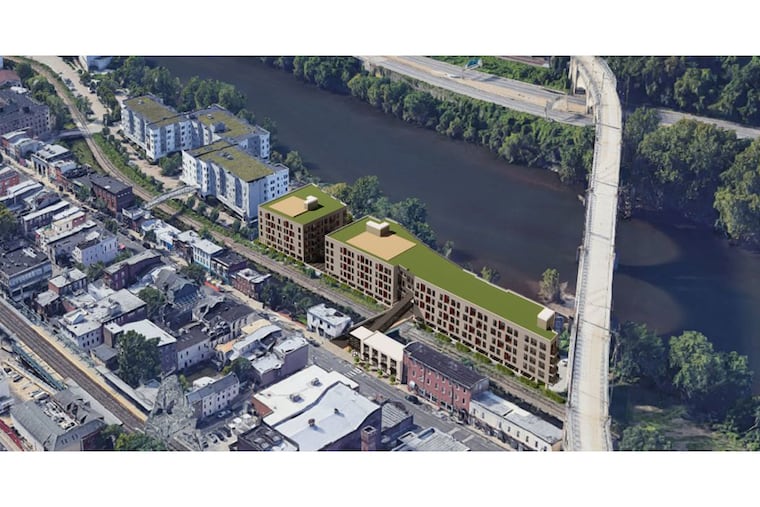Until Philly adequately addresses housing demand, risky developments like Venice Island are inevitable
Some neighborhoods have stymied new residential construction through zoning restrictions and other means. Those measures have consequences.

As anyone who lives along one of Southeastern Pennsylvania’s many rivers and creeks well knows, flooding is a fact of life.
When the heavy rains come, even the meekest stream can swell to a torrent, wreaking devastation along human habitats downstream. It is this exact phenomenon that makes building more housing on Manayunk’s Venice Island — which sits in the middle of the Schuylkill, the easternmost tip just one mile ahead of the junction with Wissahickon Creek — such a dicey proposition. But it is important to realize the root cause of these developments: rising demand to live in the neighborhoods between the Schuylkill and Wissahickon Creek, coupled with restrictive policies.
Like most Philadelphia neighborhoods, Roxborough and Manayunk saw limited development for decades. Then, seemingly overnight, things changed. A surge of demand hit the neighborhood, sending home values skyrocketing and grabbing the attention of developers. Today, the neighborhood is filled with new construction twins and townhomes, some listed for as much as $900,000. There’s also been a boom in apartment buildings, especially along Ridge Avenue and Main Street. As a result, some residents have said, “Enough.”
» READ MORE: More apartments proposed for Manayunk’s Venice Island a year after it was swamped by Hurricane Ida
It is certainly understandable to have a negative reaction to rapid change in a neighborhood you love. Roxborough and Manayunk are hardly alone in seeking to limit multifamily development going forward. Chestnut Hill, Germantown, Society Hill, Mount Airy, Strawberry Mansion, and Point Breeze are just a few of the Philadelphia neighborhoods that have sought to stymie new residential developments by creating historic designations, special zoning districts, and using other restrictions.
While these changes may accomplish what some of their supporters desire — minimal changes to the built environment of these neighborhoods — they do nothing to mitigate the strong demand for housing. Until that happens, the pressure to create more units will push developers into risky areas, such as Venice Island.
It would be easier, cheaper, and more profitable to build apartments along Main Street itself, or along Ridge Avenue in Roxborough. Not only are these locations drier than Venice Island, they are in the heart of their neighborhoods, close to the shopping, dining, and cultural attractions that drive the interest of renters and buyers in the first place.
For years, that’s what the zoning called for, too. Mixed-use residential buildings up to 45 feet tall, with the traditional Main Street arrangement of locating housing above retail businesses, were allowed to be constructed along the avenue. Earlier this year, however, the city changed the zoning to make Ridge Avenue into a more suburban-style corridor, where housing is prohibited.
In addition to downzoning the Ridge, the area has also seen historic districts proliferate. While these districts are popular with some neighbors, they aren’t popular with others. As Roxborough resident Kate Riestenberg told me earlier this year, the overlay gives the Philadelphia Historical Commission “quite a bit of jurisdiction over what we can and can’t do with the exterior of our home,” and can inflate the cost of repairs and renovations. Using a historic district to stymie multifamily development “doesn’t make sense in a world with climate change and a housing crisis,” Riestenberg said.
To placate neighborhoods opposed to more construction, Philadelphia has taken a path of least resistance — pushing development away from the heart of our neighborhoods and to the fringes of the city, like the Navy Yard and Venice Island. This may make life easier for elected officials, who have to face fewer town hall meetings with angry homeowners, but it is a disaster for the environment.
One alternative is infill development — a method of building new housing in previously underutilized spaces, such as vacant lots or abandoned commercial spaces — which has the potential to reduce emissions by up to 40%. The reluctance to do so leads to situations like we’re seeing on Venice Island, which is far from the only environmentally risky place that’s seen development as a result of anti-infill sentiment. Decades of restrictive zoning in California have been blamed for the increased development of land in forest fire territory.
Infill development may be a new phenomenon for many Philadelphians, but its existence is a sign that the city is emerging from a long period of economic stagnation and population drought. As Alex Armlovich, senior housing policy analyst at the Niskanen Center, told me, “Healthy cities permit enough new housing to keep up with job growth and to replace aging or damaged units over time. Any city that doesn’t will find itself with an unfortunate combination of scarce and expensive, yet old and dilapidated, housing.”
Philadelphia has a choice: Embrace some level of infill development, or watch the flood of housing demand push into more and more unsuitable areas, like Venice Island.